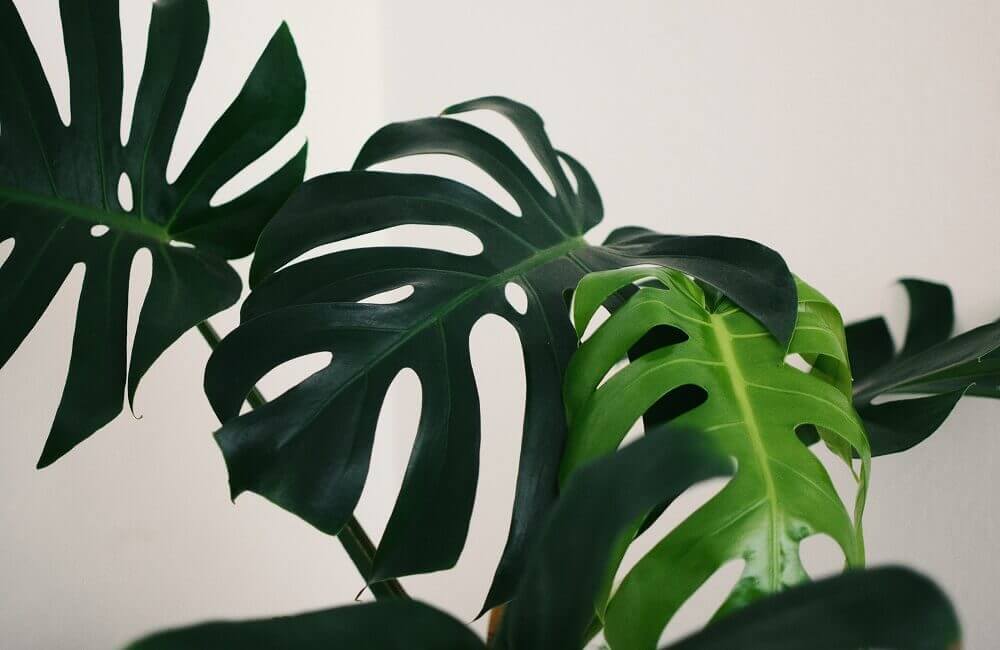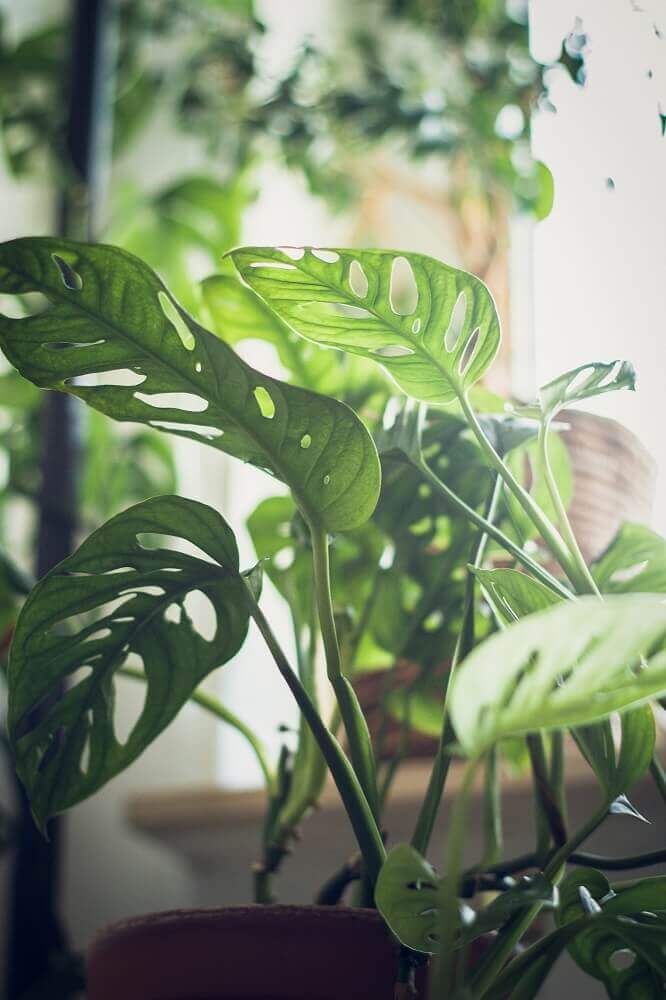
Monstera or Monstera deliciosa, a lush flowering plant native to Panama and Mexico is one of the easiest to care houseplants, making it ideal for beginners. These plants are also known as Swiss Cheese plants because of the ridges and holes on their mature leaves. But you won’t get these iconic splits if the plant does not receive an ample amount of light. So when you’re raising a beautiful and healthy monstera plant, it’s your duty to give them proper light. But how much light does a monstera plant need? What are the light requirements of Monstera deliciosa? That’s exactly what we will discuss in this article.
Lighting is one of the most essentials needs of a plant for proper growth and development and it’s no different for Monstera deliciosa. Plants make their food through a process called photosynthesis. They use carbon dioxide and water to make glucose and oxygen, which they use as a source of energy. The fertilizer that we add to them isn’t food, but a supplement for healthy growth. Sunlight plays a vital role in photosynthesis. If the plant doesn’t get enough sunlight, it will fail to make food for itself as the roots won’t be able to absorb enough water from the soil. Hence, proper light is a prerequisite when it comes to growing plants.
Table of Contents
Ideal Temperature For Monstera Plant:
Just like most sub-tropical plants, even monstera prefers a humid and warm environment with a decent amount of water and light. These plants can thrive in most kinds of lights, even the bright ones, but they perform best when they receive indirect light, especially during summers when they are trying to adjust to outdoor temperatures. The light should be such that it does not shine directly on its leaves. Monstera can tolerate low light as well, but this can lead to leggy growth, which may not look very appealing.
These plants also love humidity, even if you are growing them indoors. If you live in a dry or arid region, you can try the age-old pebble tray method to give it some humidity. Misting will also do good to your monstera plant.
How Much Light Do Monstera Plants Need?
Coming to the main question, how much light does a monstera need? Being a sub-tropical or rainforest plant, a monstera thoroughly enjoys being under bright, but indirect sunlight. Essentially, they need around 10 to 12 hours of daylight during summer and 8 to 10 hours during winters. But in winters, you’ll have to increase the humidity level so that they don’t dry out.
If natural light isn’t that great in your region, you can go for artificial grow lights. Just ensure that the emitted light replicates the daylight as closely as possible. 5500 degrees Kelvin for at least 12 hours would do the needful. Whatever light source you choose, just keep it consistent throughout the year.
Signs Your Monstera Plant Needs More Light:
-
Wet Soil:
Monstera does not do well with too much water, and certainly not with wet roots and soil. That’s not all. Wet soil can lead to root rot, which can cause immense damage to your plant. So it’s highly important to address this issue as soon as possible.
There could be two reasons behind it-overwatering and not getting enough light. You need to be very careful while watering your monstera plant. Poke your finger in the soil and if the top two inches feel dry, then only feed it some water.
Wet soil is also a cue to not getting enough light. Sunlight is required to help monstera use water properly. So if it doesn’t get enough light, the soil stays wet for a longer period of time, which isn’t healthy for a plant. If the soil feels wet even after not watering for 10 days or more, you need to show it some light.
-
Monstera Is Falling Or Leaning To One Side:
Weak and elongated stems due to lack of sunlight can make it difficult for monstera plants to stay upright. In that case, provide some support to your monstera and lots of indirect sunlight. Along with that, give it some water also. This will make a huge difference in its health and growth.
-
Leaves Not Splitting:
When a monstera is three years old, it starts showing fenestration or splitting of leaves, which is one of the prime characteristics of this plant. But if your plant fails to split even after three years, it means that there’s something wrong with the place with the plant and that problem could be insufficient light.
-
Monstera Plant Growing Slowly:
The USP of monstera plant is that it can grow huge, up to 10 feet indoors. And it doesn’t take too long for them to reach that height. If you feel that your monstera plant’s growth is stunted or if it hasn’t grown new leaves, especially during spring or summer, it could mean that it isn’t getting enough light to support its growth.
But please remember, just like every other plant, even monstera has its own growing season. If it hasn’t grown new leaves for a couple of months, it could be its dormant season. So don’t panic right away.
-
Monstera Is Leggy:
If your monstera is etiolated or stretched out, it could mean it isn’t getting enough light. The plants become elongated when they try to reach out for a light source. Leggy plants usually have long and weak petioles, the stalks that connect leaves to the stem. If your monstera has become leggy, show it come light and provide it some support using a pole. It’s also wise to prune the unhealthy leaves.
-
Leaf Discoloration:
Yellow or brown spots on your monstera plant leaves could also signal insufficient light. Apart from insufficient light, brown or yellow leaves are also symptoms of too much water, which is in fact interrelated because soil find hard to dry in low light conditions. So first cut back the amount of water you give to your plant. If that doesn’t fix the issue, move your plant to a brighter spot, preferably 2 feet from the window so that it can soak up the required amount of light.
How Does Monstera Deliciosa React To Different Light Conditions?

Direct Bright Sunlight:
Since monstera is a rainforest plant, it doesn’t like too much direct sunlight. Even outdoors, it grows under the shade of tall plants and trees. It is also believed that its fenestrated leaves have evolved over time to allow sunlight to fall onto the lower leaves. However, too much bright direct sunlight can be dangerous for monstera as it can burn the leaves. So just 2 hours of direct sunlight is more than enough for your plant.
Bright, Indirect Sunlight:
Monstera thrives best under bright, but indirect sunlight. Bright indirect light means that the sun rays do not strike the leaves. This type of light urges monstera deliciosa to expand and grow well. To give your monstera the perfect amount of indirect bright light, place it a few feet away from the window or by a window that doesn’t get too much direct sunshine.
In case you’re wondering how to know if it’s the perfect light condition for your plant, just check its shadow. If it doesn’t cast a shadow when kept under indirect sunlight, it means that it’s in its perfect spot.
Low Light:
Low light doesn’t mean no light at all. It means that the plant is kept in an area where there are enough windows, but not enough sunlight reaches them. It could be because of the placement of the plant as well. Monstera may not like direct sunlight, but that doesn’t mean it doesn’t like light at all. In fact, when it doesn’t get enough light, it climbs upwards using its aerial roots to get some, especially when it’s placed next to another plant or pole for support.
The thing with monstera deliciosa is that it is very hardy and can grow even under low light conditions. It’s just it won’t reach its highest potential. But even in low light, monstera deliciosa can reach up to 8 feet or 2.4 meters tall, which isn’t that bad. We think it’s a good option for those who do not want their monstera to grow too large in size.
Best Placement For Monstera Plant:
In order to receive the best kind of light, place your monstera plant 3-5 feet away from south-facing or east-facing window. This place is most ideal as it doesn’t receive direct sunlight but is still bright enough to help your plant grow. If you’re still worried about your plant receiving too much light, you can hang a sheer curtain to prevent the sun from scorching the leaves. Just avoid the afternoon sun as it’s the harshest and can burn the tissue leaves, giving it a brown, crispy look. If you notice burning signs on leaves, remove it from the window and keep them under grow lights for some time.
West-facing windows are not suitable because they let in direct and hot afternoon light. North-facing windows can also be considered, but they won’t be bright enough.
Apart from windows, you can even place your monstera in the living room, bedroom, or dining area, provided they receive natural light from someplace or the other.
FAQs About Monstera Deliciosa Light Requirements:
Can I grow Monstera in shade?
Yes, monstera can grow well in filtered shade as well as full indirect sunlight. The issue with monstera is that it grows slower when it gets limited sunlight. But shading works really well when you’re planting it outdoors. This will ensure that your Monstera isn’t receiving direct sunlight.
What kind of artificial light should I use for my monstera plant?
If you cannot find the right natural light spot for your monstera plant at home, we would suggest you get some grow lights. Just make sure that these lights aren’t too close to your plant. Since grow lights are measured in FC, lux, PAR, lumen, you should aim for 1000-2500 FC or 5500 degrees Kelvin. As mentioned earlier, the light emitted should be as close to natural sunlight or daylight as possible. We like this Giixer 1000W LED Grow Light a lot for our plants. Even you can give it a try.
How to know if my monstera is receiving too much sunlight?
Too much light can also affect your monstera adversely. If the leaves of your monstera have got brown spots, it means that they receiving too much light. These brown spots mainly occur when they are burnt by direct sunlight. The leaves also start curling and drooping and the soil turns dry and flaky. So keep your monstera under indirect sunlight. We just can’t stress it enough.
To conclude, monstera is a plant for everyone. It’s very easy to grow a big and healthy monstera plant, that too in no time, provided you grow them in ideal conditions, which include a steady flow of light. Just read the signs carefully so that you know when your monstera wants more light and do the needful. Even if you falter, these plants will forgive you and will continue to grow steadily. And they look amazing and would make a lovely addition to any space.
Aiza Siddiqui is one of the content providers in Gardener’s Toolbox. From a very young age, Aiza has been passionate about gardening, which explains her choice of major in studies. She holds a BSc Degree in Botany from the University of Calcutta. Aiza is a green thumb through and through and owns more than 100 different types of plants. Every article that she contributes to Gardener’s Toolbox is written by doing extensive research and from her own experience with planting and gardening. Hoping that you will find her articles on different houseplants helpful.
